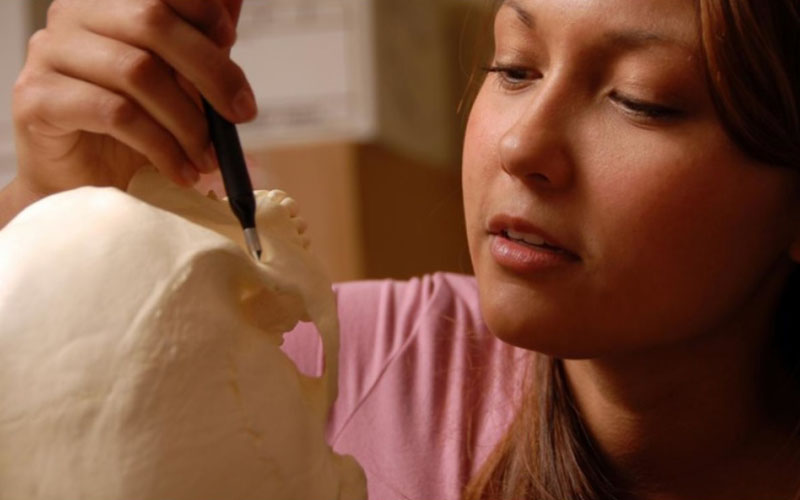A June 2017 study by scientists at North Carolina State University of skull shapes and skeletons found in ancient graves in Italy has confirmed that mass immigration from outside that country caused a racial change in the population after the establishment of the Roman Empire. The study also confirms the accuracy of cranial measurements as a means of measuring race, and refutes liberal race-denying dogma in general.

A student uses a digitizer to record geometric morphometric sites on a skull. Credit: NC State University.
According to the study, titled “Cranial variation and biodistance in three Imperial Roman cemeteries,” and published in the International Journal of Osteoarchaeology on June 1,, skeletal evidence shows that, hundreds of years after the Roman Republic conquered most of the Mediterranean world, coastal communities in what is now south and central Italy still bore distinct physical differences to one another—though the same could not be said of the area around Rome itself.
The report said that “ancient Roman populations are expected to exhibit considerable biological variation due to extensive trade networks and migration patterns throughout Europe and the circum-Mediterranean,” and that the purpose of the research was to “examine regional biological variation in Italy during Imperial Roman times (I–III Centuries AD) using three samples exhibiting distinctive class and economic systems.”
Science Daily reported that “using state-of-the-art forensic techniques, anthropologists from North Carolina State University and California State University, Sacramento examined skulls from three imperial Roman cemeteries: 27 skulls from Isola Sacra, on the coast of central Italy; 26 from Velia, on the coast of southern Italy; and 20 from Castel Malnome, on the outskirts of the city of Rome.”
All of the remains date from between the first and third centuries A.D.
The scientists investigated samples buried at Isola Sacra and Velia as representative “of the middle class tradesmen and merchants from coastal port populations from central and southern Italy respectively; while the individuals from Castel Malnome represent an inland population near Rome of freed slaves and other lower class individuals, involved in heavy labor associated with salt production.”
The scientists recorded data from 25 three-dimensional cranial coordinate landmarks and analyzed using Procrustes Superimposition and associated multivariate statistics in an integrated program package for doing geometric morphometrics known as MORPHOJ.
They were unable to detect any significant group differences for centroid size; but did detect differences in shape, “suggesting some variation between the three samples.”
The samples from Castel Malnome were not significantly different from either of the coastal sites (Isola Sacra, and Velia); but the samples from Isola Sacra and Velia were “significantly different.”
“The similarity of Castel Malnome to the other sites may reflect inherent heterogeneity in the sample, as it represents a group of freed slaves likely originating from various geographic locations,” the report said.
“The separation of the two coastal sites is not unexpected, as Velia’s location was influenced by an influx of Greek populations in the southern Italian peninsula.
“This work supports previous studies using traditional craniometrics and dental metrics showing group similarity across the Italian peninsula and a separation between more northern and southern groups.”
The researchers took measurements of 25 specific points on each skull using a “digitizer,” which is basically an electronic stylus that records the coordinates of each point. This data allowed them to perform shape analysis on the skulls, relying on “geometric morphometrics”—a field of study that characterizes and assesses biological forms.
“We found that there were significant cranial differences between the coastal communities, even though they had comparable populations in terms of class and employment,” says Ann Ross, a professor of anthropology at NC State and co-author of a paper on the work.
“We think this is likely due to the fact that the area around Velia had a large Greek population, rather than an indigenous one,” says Samantha Hens, a professor of biological anthropology at Sacramento State and lead author of the paper.
In addition, the skulls from Castel Malnome had more in common with both coastal sites than the coastal sites had with each other.
“This likely highlights the heterogeneity of the population near Rome, and the influx of freed slaves and low-paid workers needed for manual labor in that area,” Hens says.
“Researchers have used many techniques—from linguistics to dental remains—to shed light on how various peoples moved through the Roman Republic and the Roman Empire,” Ross says. “But this is the first study we know of in which anyone has used geometric morphometrics to evaluate imperial Roman remains.
“That’s important because geometric morphometrics offers several advantages,” Ross says. “It includes all geometric information in three-dimensional space rather than statistical space, it provides more biological information, and it allows for pictorial visualization rather than just lists of measurements.”
“The patterns of similarities and differences that we see help us to reconstruct past population relationships,” Hens says. “Additionally, these methods allow us to identify where the shape change is occurring on the skull, for example, in the face, or braincase, which gives us a view into what these people actually looked like.”